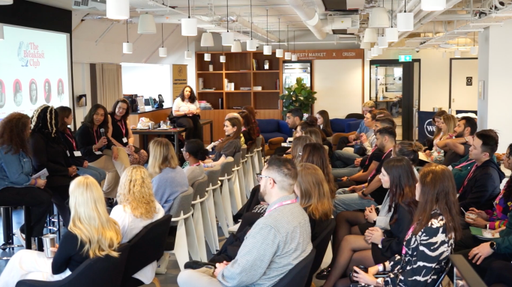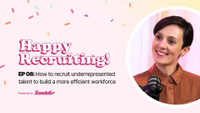Removing bias from the recruitment process


Valentina Behrouzi
I'm Val, one of the Marketing Managers here at Teamtailor, responsible for our Global marketing. I love talking about candidate experience and how we can strive to make hiring more inclusive.
Studies show that a more diverse workforce leads to a more productive and creative workplace. Hiring inclusively and without bias is an important first step, but how do you implement this alongside the risk of unconscious bias?
In our latest edition of The Breakfast Club in London, we sat down with Jessica Jones (Talent Lead at Coolr), Heidi Wassini (Talent Acquisition & Employer Branding Evangelist at heartfelt.biz), Yasmin Lord-Pottinger (Head of Academy at Agent Academy), Alicia Richardson (Lead Diversity, Equity and Inclusion Consultant at SyncD) and Alicia Riley (People and Talent Lead at Ben) to discuss the impact of removing bias from the recruitment process. Here are our top takeaways from the discussion 🚀
Have a thorough structure 🏗️
If you're planning to make your job descriptions more accessible, you need to have a clear plan and structure in place. Our panel unanimously agreed that requirements like "x number of years experience needed" for a job are mostly needless. For instance, you could come across someone with loads of experience who isn't right for the role, and vice versa, you could be excluding a bunch of really amazing candidates without realizing.
It's important to take the time to actually define the skills and competencies someone would need to have to be the right fit for the role. Once these are defined, you can then start to define the interview process and structure and ensure you and your team are aware of what this process is actually going to look like. Get others in your team involved and try to be as objective and inclusive as you can.
Another crucial element to your structure is making sure you have a solid DEI statement that you're analyzing on a consistent basis. Most DEI statements are either non-existent on a job ad or hidden right at the bottom—consider moving this to the top instead as a refreshing change for your candidates and to show you're serious about these initiatives.
Try leveraging NPS surveys or optional anonymous DEI surveys to measure both how people find your recruitment process as well as who's applying to see where and how you can make changes to reflect your goals.
Review your policies to make your hiring more accessible 🔨
More and more companies are beginning to assess their interview structures as it's becoming clear that one size does not fit all, which is why it's important to understand the difference between equality and equity. Equality gives everyone the same experiences and opportunities regardless of who they are or their background. Equity goes a step further and recognises that people have different circumstances, therefore to give everyone an equal outcome you would allocate the resources to allow that to happen.
One of the easiest ways to do this is to ask your candidates if there are any adjustments you can do to make the process more accessible for them. It can be very daunting for someone to disclose when they need a bit of extra help, therefore, making it a normal part of the process can improve the overall candidate experience. Another tip from our panel is to avoid using terminology like "reasonable adjustments" as who's to say what is and isn't reasonable?
It might be worth looking into asking your candidates how they'd like to be interviewed as well. Perhaps your candidates have kids, aren't able to travel or have bad social anxiety, none of which means they wouldn't be great for the role. So asking them their preferred style of interview makes your overall process much more accessible and opens up a wider variety of amazing talent.
If your candidates are happy to have a face-to-face interview, make sure your office is accessible as well. Again, this is a good chance to ask your interviewees if there's anything you can do to be more accommodating and what makes them most comfortable.
Leverage tech to help with unconscious bias 🙅
If it feels daunting to start, there's a lot of technology that can help keep things simple and can take some of the unconscious bias out of your hiring process.
For example, some ATSs have an anonymous screening tool, which will mask candidate's personal data in the early stages of the process. This allows you to focus more on their skills and experience, as opposed to less important factors.
There's no shortage of solutions out there to help your company with inclusivity. From tools that use AI to remove bias from job descriptions to something as simple as implementing Grammarly for any employees who may be dyslexic, the options are endless.
While these tools can be a massive help, don't forget to do your research to make sure they're not only legitimate but are compatible with your company and what you're looking to achieve.
An accessible onboarding is just as important 💪
One of the biggest pieces of advice from our previous Breakfast Club on employer branding was to make sure your onboarding process actually reflects what you’ve promised in the hiring process. There are a lot of great ways to make your onboarding process not only reflective of the candidate experience, but also as inclusive as possible.
As we've said, one size doesn't fit all and this is true for your onboarding as well. People have different levels of what they are comfortable with when it comes to starting a new company. This means not every single person will enjoy being the spotlight of a Zoom call with 200 employees. Check with your new starters on how they'd like to be introduced to the company, perhaps a simple email or message on Slack will work wonders for them, or introductory calls on a one-to-one basis instead.
Do you have regular work social events? Why not invite new starters before their official start date? Optional of course, but this gives them the opportunity to meet the team in a more relaxed, social setting and ease any anxiety before their start date. Similar to this, buddy systems can work as a great way of easing in new starters. However, depending on the candidate, it's very important that whoever they buddy up with has training or an understanding of different diverse characteristics. A lot of the time, underrepresented employees may have to adjust who they are or what they're comfortable with to accommodate the company they're working for, but with the right trainings and policies in place, this can be avoided. As always, it’s important to measure, ask for feedback and not be afraid to adjust as you go.
It won't happen overnight 💥
DEI is a long-term project, especially if you’re still in the early stages of implementation. It's likely you won't see results instantly or even a year down the line. This shouldn't deter you from taking the initiative as the benefits far outweigh the time it takes.
Remember, the next generation of candidates really value diversity and will be expecting these policies in place. So if you're not equipped to add equity to their experience and elevate your DEI strategies, there's a chance your business may not survive from excluding the next generation of talent.
Another tip from our panel to make things slightly less daunting is not to try and tackle everything at once. Take a step back, and look at what your priorities are depending on your pain points—work on what you can effectively do now and what can be done later down the line. Again, always get others involved for feedback and different opinions.
Another option is to have an external expert not only work on improving your processes but implement them too. This takes some of the pressure off and things won't be put to the wayside.
✨
Want to see how Teamtailor's all-in-one recruitment software can help your DEI efforts?
Thank you to everyone who joined The Breakfast Club! If you'd like to connect with our speakers, you can find their details below.
Jessica Jones, Talent Lead at Coolr Heidi Wassini, Talent Acquisition & Employer Branding Evangelist at heartfelt.biz Yasmin Lord-Pottinger, Head of Academy at Agent Academy Alicia Richardson, Lead Diversity, Equity and Inclusion Consultant at SyncD Alicia Riley, People and Talent Lead at Ben
A peek into the latest Breakfast Club:
![]()
How to recruit underrepresented talent to build a more efficient workforce
We sat down with Caroline Therwath-Chavier profile, to learn more about strategies for recruiting diverse talent and encourage more inclusion in the workforce.
![]()
The secret to a strong DEI strategy - Palace for Life Foundation
Duncan Robinson, Head of Operations at Palace for Life Foundation, spoke with us about the inspiring DEI strategy he has helped to implement at the organisation, which has been conducive to their significant hiring growth.
![]()
The Diversity Dilemma: True Inclusion or Statistical Illusion?
In a world where most people claim to be experts on DEI and project inclusivity as an all-you-can-eat buffet, are we interested in the person themselves?


